Abstract
The aim of this research work is “Comparative study of formulated herbal face wash containing aloe vera with marketed preparation”. The face wash was prepared by using ingredients such as aloe vera, turmeric, neem, glycerine, honey, gelatine, vitamin E, methyl paraben, sodium lauryl sulphate and rose water. The face wash was prepared by homogenous mixing of all the excipients and the herbal extracts, therefore three formulation F1, F2 and F3 was prepared and evaluated. Several evaluation test such as organoleptic properties, homogeneity, pH, grittiness, microbial growth, viscosity, spreadability test, washability test, foamability test, test for irritancy and phase separation. The herbal face wash (F1&F2) showed good appearance, foam ability, washability, spreadability, pH, non-irritant and no phase separation was observed. Also, the herbal formulation shows no redness, itching and irritation during irritancy test and they were easily washable and stable at room temperature. The marketed preparation (F3) showed good appearance, foamability, microbial growth and no phase separation, but this preparation has shown burning sensation to the skin in irritancy test & difficult to wash off from skin. Therefore, formulation F3 was not optimised preparation. Based on the physio-chemical test, herbal formulation (F1) gave excellent result for all the parameters therefore, showing better stability and safety for skin products when compared to formulation F2 and F3. This suggests the potential effectiveness of herbal ingredients in skincare products.
Keywords
Herbal face wash, preparation, skin, evaluation.
Introduction
Cosmetics are the products which are generally used to beautify the skin and also purify the skin. The word cosmetics is derived from Greek word – ?kosmesticos? which means to adorn. The materials that are used to promote appearances or to beautify the skin are called as cosmetics. From the ancient time till now people are still using poly herbal or herbal cosmetics for the beautification of skin. The use of herbal products as cosmetics is as prevalent in modern era as it was in ancient times. Herbal cosmetics are mostly preferred because it has less or nil side effects when compared to synthetic products and show enhanced effects upon application.[1]
Face skin is the major part of the body, which indicates the health of an individual It consists of materials such as amino acids, lipids and carbohydrates etc. So that a balanced nutrition is provided for the skin, that keeps it clear, glossy and healthy. It deals with the formulation and characterization of cosmetic ideal face wash preparation. In ancient times, conscious about their beauty and used to dress themselves because they wanted to increase their own beauty. Even today, people especially in rural areas, and hilly region select the natural remedies like plants extracts for cosmetics purposes like neem, aloe vera, turmeric, rose different clays to perform face washing and cleansing. Many cosmetics products are now available which are used to purify and beautify the skin. The main advantage for using these cosmetic washes and cleansing agents is that it is pure and does not have any side effects on the human body. Men have rough skin and when they don't take sufficient care then the skin turns dark due to over exposure to the sunlight which needs more attention in order to keep skin healthy and problems free.
Facial skin is delicate and ordinary soaps can cause moisture loss. A face wash is a mild cleanser that does the vital job of keeping skin clean, germ free, smooth fresh and moisturizes the horny layer without any harshness to the skin; helps look younger and energetic.
The purpose of facewash may be to impart cleansing, anti-wrinkle effect, anticancer property, moisturizing effect and fairness of skin.[2]
Face wash is highly beneficial in getting rid of dirt’s to the skin. All skin types have been proven to benefit equally from face wash products. Using a face wash every day is necessary and can help maintain healthy skin. The objectives of this work is to overcome the drawbacks of synthetic facewashes and to prepare herbal facewash so we made an attempt to formulate herbal face wash & topic is “Comparative study of formulated herbal contain aloe vera face wash with marketed preparation”
There are some important research articles that are being referred for this research work they are as follows;
- Khand gale Ganesh Sarjerao et.al., (2021) Conducted research on Formulation and Evaluation of Herbal Facewash by Using Natural Ingredients by Simple Matched. They formulated herbal facewash by using leaf of Neem, Aloe Vera, Tulsi, vit-c. Ayurvedic cosmetics is very helpful and does not give any side effects are known as herbal cosmetics. Neem has given more medicinal properties Neem and their chemical constituents have been demonstrated to exhibit anti-inflammatory, antihyperglycemic, antiulcer, antimalarial, antifungal, antibacterial, antimutagenic and anticarcinogenic property. Aloe plant is used to treat burn & skin conditions like psoriasis and even acne. They concluded that formulation containing aloe, neem, Tulsi it doesn’t show any irritation, itching, toxicity to the skin by using herbal face wash. [3]
- Shital A. Tiwar et.al., (2023) Had a delayed study on A Review on Herbal Face Wash. which is used to cleanse face without drying it and it is also commonly known as “cleanser”. This product is found to be equally good for all skin type. A face wash is a mild cleanser that does the vital job of keeping skin clean, germ free, smooth and fresh and moisturizes the horny layer without any harshness to the skin. So that skin looks young and energetic. There are various types of herbal ingredients which can be used for manufacturing of face wash. This article is a review about various types ayurvedic or herbal ingredients which can be used for production of herbal face wash.[4]
The purpose of the present research work is
- To formulate and evaluate the herbal face wash containing Aloe vera, Neem, and Turmeric for its cleansing and anti-bacterial action without causing any skin irritation.
- To compare the physiochemical parameters of different formulated herbal face wash with marketed preparation.
MATERIALS USED
Rose water
Rose water gives natural hydration to the skin. As the name rose water comes from the rich and fragrant petals of the rose flower. It has antioxidant properties and help to prevent wrinkles. Rose water proves to be effective in some of the major skin problems like dryness and breakouts.

Figure 1: Rose water
Glycerine
Glycerine also improves skin function to slow down aging. It also traps moisture in your skin and gives a youthful, healthy glow. It provides anti-irritant protection to the skin. Glycerine accelerates wound healing.[5]

Figure 2: Glycerin
Methyl paraben
Methyl paraben is one of the most common parabens. It may be used in cosmetics as a preservative to protect against microbial (e.g. bacteria, fungus) growth. This gives product compatibility and product integrity. [6]
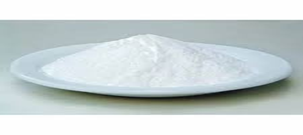
Figure 3: Methyl paraben
Sodium Lauryl Sulphate
In cosmetics, sodium Lauryl Sulphate is most often used as an emulsifier or surfactant. As an emulsifier, it helps to stabilize and thicken solutions with ingredients of differing solubility. This allows products to achieve a more uniform texture for easier, & smoother application. [7]

Figure 4: Sodium Lauryl Sulphate
Honey
Honey's natural humectant properties make it an effective moisturizer. it penetrates deeply into the skin and bring hydration to the underlying layers. This results in plumper, softer skin with a natural radiant glow. Honey is also an effective antimicrobial agent.

Figure 5: Honey
Gelatine
Gelatine is most commonly used as a gelling agent. It has moisture -retaining properties, providing deep hydration and help to revitalize the skin. Gelatine stimulates collagen production, promoting firmness and elasticity also gives a younger appearance.[8]

Figure 6: Gelatine
Vitamin E
Vitamin E containing face wash is gentle suitable for sensitive skin as it has soothing properties and helps to reverse the signs of skin aging. It also act as moisturizing agent, cleanser, it helps to lighten dark spots, relieve cold sores, stretch marks etc. [9]

Figure 7: Vitamin E
Aloe vera
Aloe vera has many skin bene?ts, making our skin glow and soft. It is a magical plant that is used in such a large number of skin and hair care items. Apart from having medicinal properties, it has a lot of nourishing bene?ts as well. Aloe has an antioxidant property that prevents skin cell damage. It has a moisturizing effect on dry skin and help reduce irritation of skin.
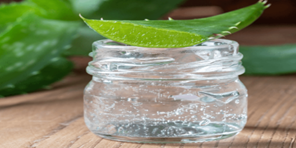
Figure 8: Aloe vera
Neem
Neem is a natural healer, so it can soothe and calm irritated skin. The antibacterial nature of neem leaves also prevents skin infections. Neem-containing face washes can help reduce redness and irritation while neem face pack gives a peaceful mind and also works effectively on blackheads and whiteheads. It has anti-aging properties that help in reducing wrinkles and fine lines.
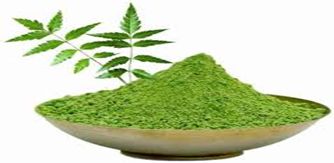
Figure 9: Neem
Turmeric
Turmeric is an amazing ingredient for skin care. It can resolve a number of skin problems, including acne, skin darkening, skin pigmentation, rashes, infections etc. It has been used since ages to boost the health and glow of the skin.[10]
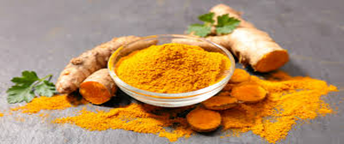
Figure10: Turmeric
Methods Used For Obtaining Plant Extract
Mature, healthy and fresh aloe vera leaves were collected and washed with distilled water. Then after proper drying of leaves in hot air oven, the outer part of the leaves was dissected longitudinally using a sterile knife. Then the aloe vera gel that is the colourless parenchymatous tissue was removed using the sterile knife. Then it is filtrated using muslin cloth to remove the Fibers and impurities. Then the filtrate or the filter product which is a clear aloe vera gel was used in the preparation.[11]
Conventional extraction using Soxhlet: The rhizomes of turmeric were dried in oven at 105°c for 3 hours. Dried rhizomes were triturated using mortar and screened through a sieve with mesh 80 to obtain uniform powder with particle size of 0.18 mm. The turmeric powder was stored in refrigerator to prevent moisture uptake, the Soxhlet extraction, as the reference method, was pre-formed as follows: 15 g ground turmeric powder was weighed and embedded in a thimble and put in the Soxhlet apparatus which was gradually filled with acetone as the extraction solvent. The extraction experiment was carried out at 60°C within 8h. Upon completion of the extraction, the acetone was separated from the extract using rotary evaporator under vacuum at 35°C. The residue was dried and weighed. In all extraction experiments acetone was used as the extraction solvent due to its high solubilization capacity. [12]
- Extraction of neem powder
The fully matured neem (azadirachta indica) leaves were collected and washed under distilled water within three times to remove complete dirt. Then the leaves were air dried for 10 days, then the dried leaves were collected and ground into a powder and stored into airtight bottles.[13]
Methods Used For Formulating Herbal Face Wash
- The face wash was prepared by using ingredients like aloe vera gel, neem, turmeric, glycerine, honey, rose water, vitamin E, sodium lauryl sulphate & methyl paraben. The face wash was prepared by homogenous mixing of all the excipients.
- Two batches of herbal face wash developed. That is formulation F1& F2 along with marketed preparation F3. These all batches were then evaluated
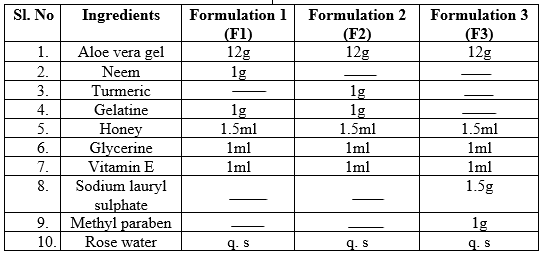
Table 1: Composition Of Herbal Face Wash
The double heat method is used for melting gelatine in face wash. 1gm of gelatine was taken & Aloe vera extract was added and mixed with continuous stirring to form aloe vera gel then the gel is used for F1&F2 preparations. F1 formulation contains aloe vera gel which was taken in a beaker. Then in this same beaker neem, honey, glycerine, vitamin E was added and mixed together with constant stirring. To this added few drops of rose water to give fragrance. F2 was also prepared in the same manner with addition turmeric instead of neem. F3 is a marketed preparation were marketed aloe vera gel, sodium lauryl sulphate, methyl paraben, honey, glycerine, vitamin E was added and mixed together. To this, added few drops of rose water as a fragrance. Then, final face wash was ready and packed in to the bottle.
Evaluation – Herbal Face Wash
- Organoleptic Properties: Organoleptic properties such as colour, odour and appearance were assessed.
- Determination of homogeneity: The homogeneity of the herbal preparation was observed by visual appearance and touch.
- Determination of pH: The pH value of freshly prepared face wash was determined by using a digital pH meter.
- Test for grittiness: The face wash was checked for the presence of any gritty particles by applying it on the skin.
- Test for microbial growth: The test carried out to determine the microbial contamination of the prepared formulation in an agar medium. The prepared face wash was inoculated on the plates of agar plate medium using streak plate method and a control was prepared without face wash. These plates were placed into the incubator and incubated at 37?C for 24 hours. After the incubation period, the plates were taken out and observed for microbial contamination in comparison with the control. [14]
- Determination of viscosity: The viscosity of the face wash can be determined by using Ostwald Viscometer.
- Spreadability test: the formulated face wash F1, F2, F3 was kept on the skin and gently spread. The degree of spreadability was determined.
- Washability test: The product was applied on hand and observed under running water.
- Test for foam ability: Foam ability can be determined by using test tube shaking method. Take 1ml of three formulated face wash and make up to 10 ml with distilled water. It was covered with hands and shaken 10 times then compare the foam with three formulations.
- Test for irritancy: Marked the area on the hand dorsal surface. Then the face wash was applied to that area and time was noted. Then it is checked for irritancy, erythema, oedema if any, for an interval up to 24 hours and reported.
- Phase separation: The prepared face wash was kept in closed container at a room temperature. Then phase separation was checked for 24 hours till 20 days. Any change in the phase separation was observed or checked. [15]
Result And Discussion
Result are as follows,
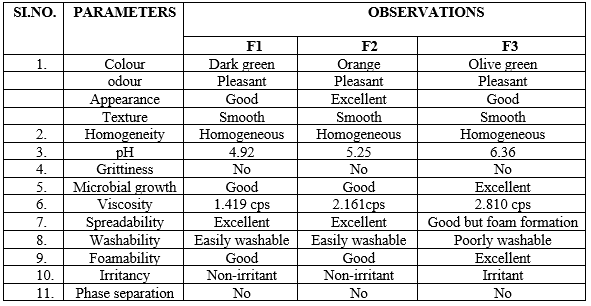
Table 2: Parameters
F1 having neem and aloe vera the main ingredient that has moisturizing, anti- bacterial and anti- ageing property. F2 having ingredients like turmeric, aloe vera has anti-microbial and wound healing activity. F3 contains marketed aloe vera preparation. The organoleptic properties of formulated herbal face wash were evaluated and results was found to be satisfactory. Other physical parameters like homogeneity, pH, test for microbial growth, viscosity, foam ability, spreadability, wash ability, irritancy, phase separation, grittiness was also evaluated. The pH of the face wash was found to be 4.5-7.0 which is suitable for skin ph. The appearance and consistency of face wash was good.
Test for microbial growth i.e. zone of inhibition was performed and compared having formulations F1, F2 & F3. It was found that F3 is more effective than F1 & F2. Because F3 used as synthetic preservative i.e. methyl paraben. The viscosity of the face wash was performed, it is measured by using Ostwald viscometer. F1 & F2 are more stable than F3, due to it is good flow property & can be easily applied on to skin. Foamability test was performed and it was observed that F1&F2 have less forms compared to F3 due to synthetic foaming agent i.e. sodium lauryl sulphate. The spreadability test was also performed & it was observed that F1&F2 have more spreadability compared to formulation F3 when applied to the skin leads to poor patient compliance as it is difficult to get removed from skin. The wash ability of the face wash was performed, it was observed that formulation F1 &F2 were easily washable while F3 was not easily washable because formulation F3 contains high concentration of foaming agent like Sodium lauryl Sulphate.
Irritancy test was performed F1&F2 are non-irritant and F3 shows irritation like burning sensation when applied to the skin. The phase separation was conducted for 24 hours for 20 days, there was no signs of phase separation that indicates all the formulations F1, F2& F3 are stable because they contain highly rich antioxidant property of aloe vera, turmeric & neem. F3 added as synthetic preservative like methyl paraben. Hence, this comparative study of herbal face wash with marketed preparation revealed that herbal formulation (F1) gave excellent result for all the parameters therefore, showing better stability and safety for skin products when compared to formulation F2 and F3.
From this research work it can be concluded that herbal skin care products are natural products that will stimulate moisturizing, anti-aging, anti-inflammatory, anti-microbial, antioxidant and wound healing activity. This herbal skin care product has fewer side effect and no irritation when compared with synthetic ones.
CONCLUSION
It is a successful attempt to create herbal face wash with a variety of plants that have therapeutic advantages. Herbal formulation has growing demand in the world market. It is a very good effort to establish an herbal facial wash, which includes aloe vera, turmeric, neem. Herbal face washes are used to refresh the muscles, keep the skin elastic, get rid of stuck-on grime, and enhance blood ?ow. The face wash gives the skin the necessary nutrition. It aids in the removal of scars, marks, and pimples. Skin is exfoliated by facewashes, which also have a cooling, soothing, and soothing impact on the skin. They do so in the quickest possible time of bring back the skin’s natural radiance. Regular usage of natural face wash enhances appearance and texture to skin. The impact of pollution and harsh conditions on the skin can be mitigated by using face wash on a regular basis. They aid in keeping skin cells elastic and prevent the skin from ageing too quickly. Natural face can be used to successfully control wrinkles, ?ne lines, and skin loosening. We discovered outstanding qualities in the face wash in our study, but more research is required to determine its full potential as a cosmetic. Natural medicines are now widely recognised since they are less likely to have negative effects than products with a chemical base and are safer. To meet the demands of the expanding global market, numerous herbal formulations are needed. It is a successful attempt to create an herbal face wash with a variety of plants that have therapeutic advantages.
In this study, it was found that the formulated herbal face wash was found to be safe, effective, non-toxic and improves patient compliance. It believes that natural remedies are more acceptable and safer with fewer side effects than the synthetic ones.
REFERENCES
- B.M Mithal et.al., a handbook of cosmetics. MK Jain for Vallabh prakashan, Delhi, Edition 1, Vol 1(1), 2000: 1-3.
- Gautham. D Mehetre et.al., Text book of cosmetic science. S Vikas and Company, Punjab, Edition 1, Vol 1(1), 2020: 48-50 & 77.
- Khandagle Ganesh Sarjerao et.al., Formulation and evaluation of herbal face wash using natural ingredients by simple matched. IRJMETS 2021; 3(11): 306-310.
- Shital A. Tiware et.al., A Review on herbal face wash. IJPCA 2023; 10 (4): 220-228.
- Ankita Sehgal et.al., Formulation and evaluation of anti-acne face wash. IJARIIE 2023; 9 (2): 1656-1658.
- Mariam Farag Ambarak, Determination of methyl paraben in some cosmetics and pharmaceutical by liquid - liquid extraction and spectrophotometric technique. AJGC 2019; Available from: https://www.researchgate.net/publication.
- Rajesh Kumar Nema et.al., Text book of cosmetics. CBS Publishers & Distributors, New Delhi, Edition 1, Vol 1(1), 2009: 198.
- Varun Dutt Sharma et.al., Pharmacognosy Practical notebook. CBS publishers & Distributors Pvt.Ltd. Edition 1, Vol 1(1), 2007: 175 & 179.
- Vinayak Borate et.al., To Formulate and Evaluate Aloe-Vera Face Wash. JMPOR, 2022; 10(4):140;Availablefrom:https://www.omicsonline.org/open-access/to-formulate-and-evaluate-aloevera-face-wash.
- Shital A. Tiware et.al., A Review on herbal face wash. IJPCA 2023; 10(4): 223-224.
- Pallavi T. Madavi et.al., preparation and evaluation of herbal face wash. IJCRT 2023; 11(12): 130.
- Foozie Sahne et.al., extraction of bio active compound curcumin from turmeric via different routes: A comprehensive study. PJBT 2016; 13(3): 173-180.
- U. Seeta Udaya Kumar et.al., Extracted Compounds from Neem Leaves as Antimicrobial Agent on the Physio-Chemical Properties of Seaweed-Based Biopolymer Films. MDPI 2020; 12(5): 3.
- Khandagle Ganesh Sarjerao et.al., Formulation and evaluation of herbal face wash using natural ingredients by simple matched. IRJMETS 2021; 3(11): 310.
- Shital.V. Sirsat et.al., Formulation and evaluation of herbal cosmetics. IJNRD 2022; 11(5): 1481-1500.


 ATHULYA LAL *
ATHULYA LAL *
 Nimisha Mathew
Nimisha Mathew
 Lincy John
Lincy John












 10.5281/zenodo.11543092
10.5281/zenodo.11543092